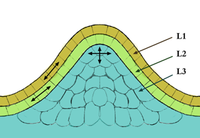
Mutagenesis of a Lotus japonicus GSK3β/Shaggy-like kinase reveals functionally conserved regulatory residues.
Sign Up to like & getrecommendations! Published in 2021 at "Phytochemistry"
DOI: 10.1016/j.phytochem.2021.112707
Abstract: The glycogen synthase kinases 3 family (GSK3s/SKs; serine/threonine protein kinases) is conserved throughout eukaryotic evolution from yeast to plants and mammals. We studied a plant SK kinase from Lotus japonicus (LjSK1), previously implicated in nodule… read more here.
Keywords: mutagenesis; kinase; lotus japonicus; mutagenesis lotus ... See more keywords

Extreme genetic signatures of local adaptation during Lotus japonicus colonization of Japan
Sign Up to like & getrecommendations! Published in 2020 at "Nature Communications"
DOI: 10.1038/s41467-019-14213-y
Abstract: Colonization of new habitats is expected to require genetic adaptations to overcome environmental challenges. Here, we use full genome re-sequencing and extensive common garden experiments to investigate demographic and selective processes associated with colonization of… read more here.
Keywords: extreme genetic; lotus japonicus; local adaptation; japan ... See more keywords

Interplay between rhizobial nodulation and arbuscular mycorrhizal fungal colonization in Lotus japonicus roots.
Sign Up to like & getrecommendations! Published in 2022 at "Journal of applied microbiology"
DOI: 10.1093/jambio/lxac010
Abstract: AIMS This study aims to identify main factors that influence the tripartite association of legumes with arbuscular mycorrhiza fungi (AMF) and nitrogen-fixing rhizobia. METHODS AND RESULTS Concurrent inoculations with Mesorhizobium loti and four AMF strains… read more here.
Keywords: nodulation; lotus japonicus; colonization; amf strains ... See more keywords

LAZY3 plays a pivotal role in positive root gravitropism in Lotus japonicus
Sign Up to like & getrecommendations! Published in 2019 at "Journal of Experimental Botany"
DOI: 10.1093/jxb/erz429
Abstract: LAZY3, polarly localized to the plasma membrane in root stele cells, is involved in rootward polar auxin transport in roots and required for positive root gravitropism in Lotus japonicus. read more here.
Keywords: lotus japonicus; positive root; gravitropism lotus; root ... See more keywords

Molecular Characterization of LjSWEET3, a Sugar Transporter in Nodules of Lotus japonicus
Sign Up to like & getrecommendations! Published in 2017 at "Plant and Cell Physiology"
DOI: 10.1093/pcp/pcw190
Abstract: Symbiotic nitrogen fixation in legumes contributes greatly to the global nitrogen cycle on the earth. In nodules, resident rhizobia supply nitrogen nutrient fixed from atmospheric N2 to the host plant; in turn, the plant provides… read more here.
Keywords: japonicus; lotus japonicus; nodules lotus; ljsweet3 sugar ... See more keywords

Distinct signaling routes mediate intercellular and intracellular rhizobial infection in Lotus japonicus.
Sign Up to like & getrecommendations! Published in 2020 at "Plant physiology"
DOI: 10.1093/plphys/kiaa049
Abstract: Rhizobial infection of legume roots during the development of nitrogen fixing root nodules can occur intracellularly, through plant-derived infection threads traversing cells, or intercellularly, via bacterial entry between epidermal plant cells. Although it is estimated… read more here.
Keywords: cytokinin; lotus japonicus; infection; distinct signaling ... See more keywords

Intragenic complementation at the Lotus japonicus CELLULOSE SYNTHASE-LIKE D1 locus rescues root hair defects.
Sign Up to like & getrecommendations! Published in 2021 at "Plant physiology"
DOI: 10.1093/plphys/kiab204
Abstract: Root hair cells form the primary interface of plants with the soil environment, playing key roles in nutrient uptake and plant defense. In legumes, they are typically the first cells to become infected by nitrogen-fixing… read more here.
Keywords: synthase like; lotus japonicus; root hair; cellulose synthase ... See more keywords

FER and LecRK show haplotype-dependent cold-responsiveness and mediate freezing tolerance in Lotus japonicus
Sign Up to like & getrecommendations! Published in 2022 at "Plant Physiology"
DOI: 10.1093/plphys/kiac533
Abstract: Abstract Many plant species have succeeded in colonizing a wide range of diverse climates through local adaptation, but the underlying molecular genetics remain obscure. We previously found that winter survival was a direct target of… read more here.
Keywords: freezing tolerance; lotus japonicus; japonicus; show haplotype ... See more keywords

A member of the ALOG gene family has a novel role in regulating nodulation in Lotus japonicus.
Sign Up to like & getrecommendations! Published in 2019 at "Journal of integrative plant biology"
DOI: 10.1111/jipb.12711
Abstract: Legumes can control the number of symbiotic nodules that form on their roots, thus balancing nitrogen assimilation and energy consumption. Two major pathways participate in nodulation: the Nod factor (NF) signaling pathway which involves recognition… read more here.
Keywords: lotus japonicus; nodulation; role; regulating nodulation ... See more keywords

Use of the rhizobial type III effector gene nopP to improve Agrobacterium rhizogenes-mediated transformation of Lotus japonicus
Sign Up to like & getrecommendations! Published in 2021 at "Plant Methods"
DOI: 10.1186/s13007-021-00764-z
Abstract: Background Protocols for Agrobacterium rhizogenes -mediated hairy root transformation of the model legume Lotus japonicus have been established previously. However, little efforts were made in the past to quantify and improve the transformation efficiency. Here,… read more here.
Keywords: lotus japonicus; transformation; agrobacterium rhizogenes; japonicus ... See more keywords

Identification of novel genes involved in phosphate accumulation in Lotus japonicus through Genome Wide Association mapping of root system architecture and anion content
Sign Up to like & getrecommendations! Published in 2019 at "PLoS Genetics"
DOI: 10.1371/journal.pgen.1008126
Abstract: Phosphate represents a major limiting factor for plant productivity. Plants have evolved different solutions to adapt to phosphate limitation ranging from a profound tuning of their root system architecture and metabolic profile to the evolution… read more here.
Keywords: root system; lotus japonicus; plant; system architecture ... See more keywords